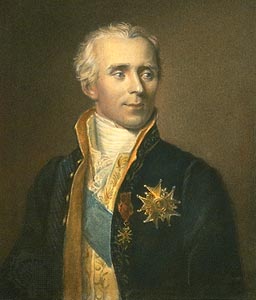
Pierre-Simon Laplace, a French astronomer and mathematician, proposed his Nebular Hypothesis in 1795. It was a refined version of Kant’s earlier theory, created to explain the origin of the solar system based on scientific principles. His work was heavily influenced by observations of nebulae in space and the rings around Saturn.
Laplace supported and built upon Newton’s law of gravitation, and he explained how the motions of planets and other celestial bodies in the solar system (like their orbits and rotations) could be understood using this law.
In simple terms:
- Newton said gravity pulls objects toward one another.
- Laplace used this idea to mathematically explain how the solar system formed and behaved, especially in the context of his Nebular Hypothesis.
The Theory:
Laplace’s theory started with a single, vast, hot, and rotating nebula that formed the entire solar system through a step-by-step process:

- Cooling & Contraction: The hot nebula began to cool by radiating heat, causing it to shrink under its own gravity.
- Increased Rotation: As the nebula contracted, its speed of rotation (angular velocity) increased.
- Ring Separation: The rotation became so fast that the centrifugal force at the equator overpowered gravity, causing a ring of material to be thrown off.
- Planet & Sun Formation: This process repeated, creating multiple rings. The material in each ring condensed to form a planet, while the central mass remained as the Sun.
- Satellite Formation: The new planets repeated the same process on a smaller scale, shedding rings that formed moons.
Merits: What the Hypothesis Explained
For its time, the theory successfully explained several key observations:
- Why do all planets orbit on the same plane?
- Why do all planets rotate and revolve in the same direction?
- The reason for the hot interior of planets.
- The similar chemical composition of bodies in the solar system.
Laplace’s theory correctly predicted that a shrinking nebula would spin faster, just like an ice skater pulling in their arms. But this means the Sun, which formed from the vast majority of the nebula’s material, should be spinning incredibly fast.
Demerits: The Major Flaws
Later scientific discoveries revealed critical flaws that the hypothesis could not overcome:
- The Angular Momentum Problem: This was the biggest issue. The Sun holds 99.9% of the solar system’s mass but only 1% of its angular momentum. According to the theory, the Sun should be spinning hundreds of times faster than it is.
- Ring Condensation: Physicist James C. Jeans proved that the separated rings would not have enough mass to gravitationally condense into planets; they would have dispersed.
- Orbital Inclination: The theory predicted parallel orbits, but there is a 6° angle between the planes of the Sun and the planets.
- No Solar Bulge: A rapidly spinning body should have a bulge at its equator, which the present-day Sun does not.
- Kinetic Theory of Gases: The random motion of gas particles would have caused them to disperse rather than form stable rings.
- Retrograde Motion: It could not explain why some moons revolve in the opposite direction.
Laplace’s Nebular Hypothesis
Initially, there was a vast, hot, and slowly rotating nebula.
The nebula began to cool and contract under its own gravity.
As the nebula contracted, its speed of rotation increased dramatically.
Centrifugal force at the equator overpowered gravity, causing a ring of material to be thrown off.
This process repeated, creating multiple rings that condensed into planets, while the center became the Sun.
The new planets repeated the same process on a smaller scale, forming their own moons.
Roche’s Modification Of Laplace’s Nebular Hypothesis (1873)
To address some criticisms, French scientist Édouard Roche modified the theory, suggesting that nine separate rings were shed one after another, rather than a single ring breaking up. However, this did not solve the central angular momentum problem.